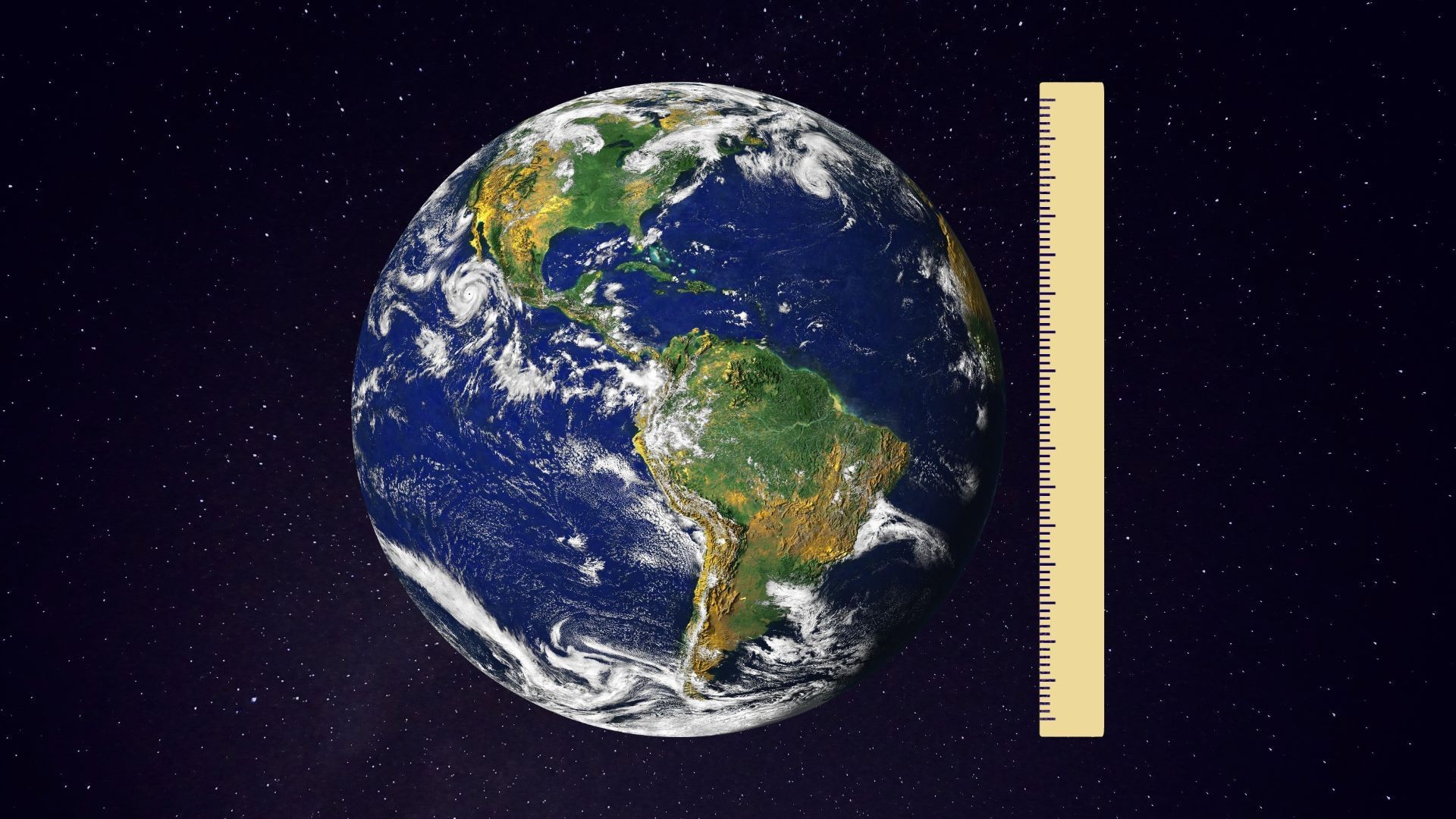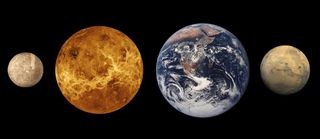How Big Is The Earth Compared To Other Planets? Earth, our home, is a unique planet with features that have allowed life to flourish, and at COMPARE.EDU.VN, we help you explore its dimensions and place in the cosmos. Discover how Earth stacks up against its planetary neighbors in terms of size, mass, and density, while also gaining a deeper understanding of the Earth’s physical attributes and significance among celestial bodies, including planetary comparisons and relative planet sizes.
1. Understanding Earth’s Vital Statistics
Before diving into comparisons, let’s establish a solid understanding of Earth’s key measurements. These figures define our planet and set the stage for understanding its place in the solar system.
1.1. Radius, Diameter, and Circumference
- Equatorial Radius: 3,963 miles (6,378 kilometers) – The distance from Earth’s center to the equator.
- Polar Radius: 3,950 miles (6,356 kilometers) – The distance from Earth’s center to either pole.
- Diameter: 7,926 miles (12,756 km) – Measured through the equator.
- Equatorial Circumference: 24,901 miles (40,075 km) – The distance around Earth at the equator.
- Meridional Circumference: 24,860 miles (40,008 km) – The distance around Earth from North Pole to South Pole.
1.2. Shape: An Oblate Spheroid
Earth isn’t a perfect sphere. It bulges at the equator due to the centrifugal force caused by its rotation. This bulge gives Earth its shape, known as an oblate spheroid, which is crucial for accurate measurements and calculations.
1.3. Volume, Mass, Density, and Surface Area
- Volume: 260 billion cubic miles (1.086 trillion cubic kilometers).
- Mass: 6.6 x 10^21 tons (6 x 10^21 metric tons).
- Density: 5.5 grams per cubic centimeter.
- Surface Area: 197 million square miles (510 million square kilometers), with 29% land and 71% water.
2. A Brief History of Measuring Earth
Understanding how we came to know Earth’s size adds context to these figures.
2.1. Early Attempts by Philosophers
Greek philosopher Aristotle made one of the earliest attempts to determine Earth’s circumference, estimating it to be about 45,500 miles (73,225 km).
2.2. Eratosthenes’ Ingenious Method
Around 250 B.C., Eratosthenes used trigonometry and the position of the sun to calculate Earth’s circumference with remarkable accuracy, within 1% of the actual value. This laid the foundation for geodesy, the science of measuring Earth’s size and properties.
2.3. Modern Geodesy
Today, scientists use advanced technologies to refine Earth measurements, improving upon the principles established by Eratosthenes. These measurements are crucial for mapping, navigation, and understanding the planet’s dynamics.
3. Factors Influencing Earth’s Shape and Size
Several factors play a role in shaping Earth and influencing its size.
3.1. Rotation and the Equatorial Bulge
Earth’s rotation causes it to bulge at the equator and flatten at the poles. The rotational speed is faster at the equator, resulting in a stronger centrifugal force.
3.2. Gravitational Pull
The equatorial bulge also affects gravity, making it slightly weaker at the equator than at the poles. This difference is considered when planning space launches, making the equator an ideal location.
3.3. Internal Structure
Earth’s internal structure, including the core, mantle, and crust, contributes to its overall density and shape. The iron-rich core is particularly significant in determining Earth’s high density.
4. Earth Compared to Other Planets: A Detailed Look
Now, let’s compare Earth to its planetary neighbors in the solar system.
4.1. Earth vs. the Gas Giants
The gas giants – Jupiter, Saturn, Uranus, and Neptune – dwarf Earth in size.
4.1.1. Jupiter: The King of Planets
- Diameter: 86,881 miles (139,822 km), about 11 times wider than Earth.
- Volume: 343 trillion cubic miles (1,431 trillion cubic kilometers), requiring about 1,320 Earths to fill.
- Great Red Spot: A storm on Jupiter wider than the entire Earth.
4.1.2. Saturn: The Ringed Giant
- Diameter: 72,367 miles (116,460 km), roughly 9 times wider than Earth.
- Volume: 217 trillion cubic miles (900 trillion cubic kilometers), accommodating about 830 Earths.
- Density: Significantly less dense than Earth, as it’s primarily composed of gas.
4.1.3. Uranus: The Sideways Planet
- Diameter: 31,518 miles (50,724 km), about 4 times wider than Earth.
- Volume: 68 trillion cubic miles (285 trillion cubic kilometers), fitting about 63 Earths.
- Unique Tilt: Rotates on its side, influencing its weather patterns and magnetic field.
4.1.4. Neptune: The Distant Blue World
- Diameter: 30,599 miles (49,244 km), approximately 4 times wider than Earth.
- Volume: 57 Earths could fill Neptune’s volume.
- Winds: Fastest winds in the solar system, exceeding 1,200 mph.
4.2. Earth vs. the Inner, Rocky Planets
While Earth is smaller than the gas giants, it’s the largest of the inner, rocky planets.
4.2.1. Venus: Earth’s Closest Twin
- Diameter: 7,521 miles (12,104 km), slightly smaller than Earth.
- Density: Similar to Earth, indicating a comparable composition.
- Atmosphere: Dense and toxic, leading to a runaway greenhouse effect and extreme surface temperatures.
4.2.2. Mars: The Red Planet
- Diameter: 4,212 miles (6,779 km), about half the size of Earth.
- Volume: Approximately 15% of Earth’s volume.
- Surface Features: Home to the largest volcano and deepest canyon in the solar system.
4.2.3. Mercury: The Swift Planet
- Diameter: 3,032 miles (4,879 km), about one-third the size of Earth.
- Density: High density, similar to Earth, due to its large iron core.
- Proximity to the Sun: Closest planet to the sun, experiencing extreme temperature variations.
4.3. Comparative Table of Planetary Sizes
| Planet | Diameter (miles) | Diameter (km) | Volume (Earths) |
|---|---|---|---|
| Jupiter | 86,881 | 139,822 | 1,320 |
| Saturn | 72,367 | 116,460 | 830 |
| Uranus | 31,518 | 50,724 | 63 |
| Neptune | 30,599 | 49,244 | 57 |
| Earth | 7,926 | 12,756 | 1 |
| Venus | 7,521 | 12,104 | 0.86 |
| Mars | 4,212 | 6,779 | 0.15 |
| Mercury | 3,032 | 4,879 | 0.056 |


5. The Significance of Earth’s Size and Density
Earth’s size and density play crucial roles in making it habitable.
5.1. Gravity and Atmosphere
Earth’s size provides sufficient gravity to retain a substantial atmosphere, protecting the surface from harmful radiation and regulating temperature.
5.2. Geological Activity
Earth’s internal heat, partly due to its size, drives geological activity like plate tectonics, which is essential for recycling nutrients and maintaining a stable climate.
5.3. Magnetic Field
The molten iron core, influenced by Earth’s size and rotation, generates a magnetic field that shields the planet from solar winds.
6. Understanding Earth-like Planets Beyond Our Solar System
6.1 Defining Earth-Like Planets
When considering planets outside our solar system, defining what makes a planet “Earth-like” is crucial. Factors include:
- Mass and Composition: Similar mass and rocky composition to Earth.
- Distance from Star: Orbiting within the habitable zone, allowing for liquid water.
- Magnetic Field: Presence of a magnetic field to protect the surface.
- Moons: Presence of moons to stabilize the planet’s rotation.
6.2 Challenges in Finding True Earth Analogues
Despite advancements in exoplanet detection, finding true Earth analogues remains challenging:
- Distance: Vast distances make detailed observations difficult.
- Technology Limitations: Current technology has limitations in detecting smaller, Earth-sized planets.
- Data Interpretation: Interpreting available data to determine planetary characteristics is complex.
7. Expert Insights on Earth’s Uniqueness
7.1 Interview with Dr. Emily Carter, Astrophysicist
Dr. Emily Carter, a renowned astrophysicist, shares her insights on Earth’s unique characteristics.
- What makes Earth special?
Earth’s unique combination of size, distance from the sun, and presence of liquid water makes it habitable. - How common are Earth-like planets?
While potentially common, finding planets with the exact conditions for life as we know it remains a challenge.
7.2 Perspectives on Planetary Dynamics
Understanding planetary dynamics is crucial for comprehending the factors that shape our planet.
- Internal Processes: Studying the chemistry of rocks and meteorites to track Earth’s history.
- Seismic Waves: Analyzing earthquake waves to image the Earth’s interior.
- Theoretical Modeling: Using physics and chemistry laws to model processes that shape the planet.
8. FAQs About Earth’s Size and Comparisons
8.1. Why is Earth bigger at the equator?
Earth bulges at the equator due to the centrifugal force caused by its rotation, resulting in a faster rotational speed at the equator than at the poles.
8.2. How does Earth’s density compare to other planets?
Earth and Mercury are the densest planets in the solar system, with densities similar to iron-rich minerals like hematite.
8.3. What is the highest point on Earth?
The highest point on Earth’s surface is the top of Mount Everest, which peaks at 29,029 feet (8,848 meters) above sea level.
8.4. How was Earth’s size first accurately measured?
Eratosthenes used trigonometry and the position of the sun to calculate Earth’s circumference with remarkable accuracy around 250 B.C.
8.5. What is an oblate spheroid?
An oblate spheroid is a sphere that is flattened at its poles and bulges at its equator, which is the shape of Earth.
8.6. How does Earth’s magnetic field affect its habitability?
Earth’s magnetic field shields the planet from harmful solar winds, protecting its atmosphere and surface.
8.7. Why is the equator an ideal location for space launches?
The equatorial bulge means that the gravitational pull of Earth is slightly weaker at the equator, making it an ideal location for space launches.
8.8. What are the key factors that make a planet Earth-like?
Key factors include similar mass and composition, orbiting within the habitable zone, and having a protective magnetic field.
8.9. How does plate tectonics contribute to Earth’s habitability?
Plate tectonics recycle nutrients and maintain a stable climate, contributing to Earth’s habitability.
8.10. What role does Earth’s internal structure play in its properties?
Earth’s internal structure, including the iron-rich core, influences its density, magnetic field, and geological activity.
9. Additional Resources for Further Exploration
- NASA’s Planetary Fact Sheet: Provides detailed information about Earth and other planets.
- Cool Cosmos by CalTech: Offers accessible explanations of astronomical concepts.
- NOAA’s History of Geodesy: Explores the historical methods of measuring Earth.
- Open University: Provides insights into planetary densities.
10. Conclusion: Earth’s Unique Place in the Cosmos
Earth, with its unique size, density, and composition, holds a special place in the cosmos. While the gas giants dwarf our planet, and the rocky planets offer intriguing contrasts, Earth remains the only known planet to support life as we know it. Understanding Earth’s dimensions and comparing them to other planets enhances our appreciation for the delicate balance that sustains life on our home world.
Want to delve deeper into planetary comparisons and make informed decisions? Visit COMPARE.EDU.VN today! Discover detailed analyses, expert insights, and comprehensive comparisons to satisfy your curiosity and guide your decisions. Our resources are meticulously crafted to provide clarity and empower you with the knowledge you need. Explore now and unlock a universe of understanding!
Address: 333 Comparison Plaza, Choice City, CA 90210, United States.
Whatsapp: +1 (626) 555-9090
Website: compare.edu.vn